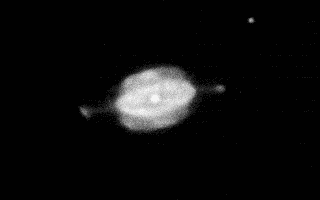 The
Saturn nebula is a bright planetary nebula in Aquarius. One of the
finest of its class, it has a diameter of 25" and is large
enough to be obviously non-stellar even at 50x. Look for an
elongated star. After you find it use as much magnification as
conditions will permit. The
Saturn nebula is a bright planetary nebula in Aquarius. One of the
finest of its class, it has a diameter of 25" and is large
enough to be obviously non-stellar even at 50x. Look for an
elongated star. After you find it use as much magnification as
conditions will permit.
This nebula was
discovered by William Herschel on September 7, 1782. Burnham's says
of NGC 7009, "It was called by Lord Rosse the
"Saturn" Nebula from the extending rays of ansae which
project from the main disc on either side... The nebula is a
strikingly beautiful object in large telescopes, shining with a
vivid green fluorescent glow."
I noted in my log that
the Saturn nebula is about twice the size of NGC 7027 (a fine
planetary in Cygnus detailed elsewhere) and much brighter. In
smallers scopes it appears as an egg-shaped blob with fuzzy edges.
In my 18-inch f/4.5 Dob I could see the famous extensions with
averted vision. At the center appeared a slightly brighter knot or
central star. A bright, oblong inner ring was apparent. The color is
most apparent when viewed directly. It is interesting to compare the
view with and without averted vision as the nebula takes on a
distinctly different apperance. When viewed directly it looks
dimmer, as if looking though a cloud or filter. It appears both
briighter and paler when viewed with your eye directed to the side
and a faint outer glow appears.

The view in a 6" at 50x.
North is down and East is right.
|